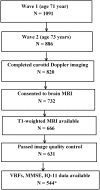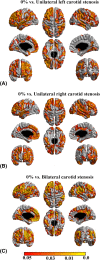Association between carotid atheroma and cerebral cortex structure at age 73 years
- PMID: 30179274
- PMCID: PMC6328248
- DOI: 10.1002/ana.25324
Association between carotid atheroma and cerebral cortex structure at age 73 years
Abstract
Objective: To examine the relationship between carotid atherosclerosis and cerebral cortical thickness and investigate whether cortical thickness mediates the association between carotid atheroma and relative cognitive decline.
Methods: We assessed 554 community-dwelling subjects (male/female: 296/258) from the Lothian Birth Cohort 1936 who underwent brain magnetic resonance imaging and carotid Doppler ultrasound studies at age 73 years. The relationship between carotid atherosclerosis markers (internal carotid artery stenosis, intima-media thickness, velocity, pulsatility, and resistivity indexes) and vertex-wide cerebral cortical thickness was examined cross-sectionally, controlling for gender, extensive vascular risk factors (VRFs), and intelligence quotient at age 11 (IQ-11). We also determined the association between carotid stenosis and a composite measure of fluid intelligence at age 73 years. A mediation model was applied to examine whether cortical thickness mediated the relationship between carotid stenosis and cognitive function.
Results: A widespread negative association was identified between carotid stenosis (median = 15%) and cerebral cortical thickness at age 73 years, independent of the side of carotid stenosis, other carotid measures, VRFs, and IQ-11. This association increased in an almost dose-response relationship from mild to severe degrees of carotid stenosis, across the anterior and posterior circulation territories. A negative association was also noted between carotid stenosis and fluid intelligence (standardized beta coefficient = -0.151, p = 0.001), which appeared partly (approximately 22%) mediated by carotid stenosis-related thinning of the cerebral cortex.
Interpretation: The findings suggest that carotid stenosis represents a marker of processes that accelerate aging of the cerebral cortex and cognition that is in part independent of measurable VRFs. Cortical thinning within the anterior and posterior circulation territories partially mediated the relationship between carotid atheroma and fluid intelligence. Ann Neurol 2018;84:576-587.
© 2018 The Authors. Annals of Neurology published by Wiley Periodicals, Inc. on behalf of American Neurological Association.
Figures






Similar articles
-
Carotid artery atherosclerosis, MRI indices of brain ischemia, aging, and cognitive impairment: the Framingham study.Stroke. 2009 May;40(5):1590-6. doi: 10.1161/STROKEAHA.108.535245. Epub 2009 Mar 5. Stroke. 2009. PMID: 19265054 Free PMC article.
-
Cortical Cerebral Microinfarcts on 3T Magnetic Resonance Imaging in Patients With Carotid Artery Stenosis.Stroke. 2019 Mar;50(3):639-644. doi: 10.1161/STROKEAHA.118.023781. Stroke. 2019. PMID: 30744544
-
Altered cerebral hemodyamics and cortical thinning in asymptomatic carotid artery stenosis.PLoS One. 2017 Dec 14;12(12):e0189727. doi: 10.1371/journal.pone.0189727. eCollection 2017. PLoS One. 2017. PMID: 29240808 Free PMC article.
-
Cortical thickness and cognitive performance in asymptomatic unilateral carotid artery stenosis.BMC Cardiovasc Disord. 2019 Jun 25;19(1):154. doi: 10.1186/s12872-019-1127-y. BMC Cardiovasc Disord. 2019. PMID: 31238977 Free PMC article.
-
Radiation-associated carotid artery atherosclerosis: case report and review of contemporaneous literature.Spec Care Dentist. 2009 Mar-Apr;29(2):75-9. doi: 10.1111/j.1754-4505.2008.00066.x. Spec Care Dentist. 2009. PMID: 19284506 Review.
Cited by
-
Microstructural Alterations Analogous to Accelerated Aging of the Cerebral Cortex in Carotid Occlusive Disease.Clin Neuroradiol. 2021 Sep;31(3):709-720. doi: 10.1007/s00062-020-00928-9. Epub 2020 Jul 7. Clin Neuroradiol. 2021. PMID: 32638029 Free PMC article.
-
Integrating multiple brain imaging modalities does not boost prediction of subclinical atherosclerosis in midlife adults.Neuroimage Clin. 2022;35:103134. doi: 10.1016/j.nicl.2022.103134. Epub 2022 Jul 29. Neuroimage Clin. 2022. PMID: 36002967 Free PMC article.
-
A novel rat model of cerebral small vessel disease based on vascular risk factors of hypertension, aging, and cerebral hypoperfusion.Hypertens Res. 2024 Aug;47(8):2195-2210. doi: 10.1038/s41440-024-01741-4. Epub 2024 Jun 13. Hypertens Res. 2024. PMID: 38872026
-
Is carotid artery atherosclerosis associated with poor cognitive function assessed using the Mini-Mental State Examination? A systematic review and meta-analysis.BMJ Open. 2022 Apr 19;12(4):e055131. doi: 10.1136/bmjopen-2021-055131. BMJ Open. 2022. PMID: 35440451 Free PMC article.
-
Cognitive Performance is Associated with Altered Cerebral Hemodynamics Assessed by Transcranial Ultrasound in Parkinson's Disease.Neuropsychiatr Dis Treat. 2022 Jul 12;18:1421-1431. doi: 10.2147/NDT.S358150. eCollection 2022. Neuropsychiatr Dis Treat. 2022. PMID: 35855751 Free PMC article.
References
-
- Tsivgoulis G, Vemmos K, Papamichael C, et al. Common carotid artery intima‐media thickness and the risk of stroke recurrence. Stroke 2006;37:1913–1916. - PubMed
-
- Muller M, Grobbee DE, Aleman A, et al. Cardiovascular disease and cognitive performance in middle‐aged and elderly men. Atherosclerosis 2007;190:143–149. - PubMed
-
- Bots ML, Breslau PJ, Briet E, et al. Cardiovascular determinants of carotid artery disease. The Rotterdam Elderly Study. Hypertension 1992;19:717–720. - PubMed
Publication types
MeSH terms
Grants and funding
LinkOut - more resources
Full Text Sources
Other Literature Sources
Medical

